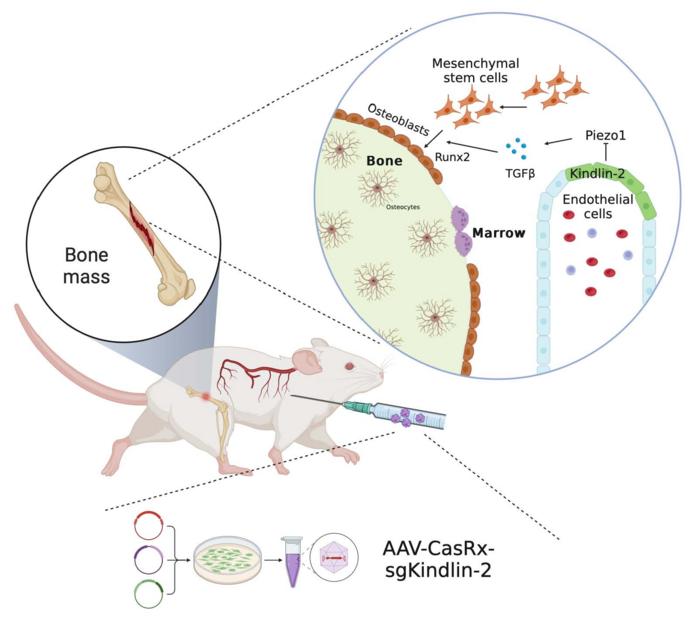New research highlights a pivotal breakthrough in bone biology, emphasizing the crucial role of endothelial cells in regulating bone formation and homeostasis through their conversion into osteoblasts. The study unveiled the intricate mechanisms behind endothelial-to-osteoblast conversion, providing insights that could reshape therapeutic approaches for conditions such as osteoporosis. By exploring the complex interplay of various molecular pathways, the research offers a fresh perspective on how endothelial cells contribute not only to vascular functions but also to bone health and maintenance.
A key experiment demonstrated that the knockdown of Kindlin-2 in human umbilical vein endothelial cells (HUVECs) and an endothelial-specific knockout murine model significantly enhanced the conversion to osteoblasts. Researchers observed notable morphological changes and an increased expression of critical osteogenic markers. This observation suggests that manipulating endothelial cellular pathways may yield beneficial outcomes for enhancing bone formation and repair, particularly in the context of diseases where bone density is compromised.
Notably, the research found that the increase in bone mass due to endothelial-specific Kindlin-2 haploinsufficiency was mediated by Runx2, a well-established transcription factor essential for osteogenesis. The findings indicate a direct correlation between endothelial signaling and bone mass regulation, positioning Runx2 as a central player in translating endothelial signals into osteogenic outcomes. This connection between endothelial cells and bone health opens new avenues for understanding bone pathology and offers potential therapeutic targets.
Moreover, Kindlin-2 was discovered to interact with Trim28, a protein that enhances the ubiquitination and degradation of Piezo1. The study provides compelling evidence that a deficiency in Kindlin-2 results in increased Piezo1 protein levels. By inhibiting the ubiquitination process or promoting degradation, researchers were able to reverse this increase, highlighting how endothelial signaling can modulate the stability of osteogenic machinery.
Exploring the role of Piezo1, which is recognized as a mechanosensitive ion channel, the researchers established that its activation through a specific agonist leads to increased osteogenic marker expression. This finding substantively supports the hypothesis that mechanotransduction pathways are integral to the process of endothelial-to-osteoblast conversion, underscoring the potential of Piezo1 as a therapeutic target in bone regeneration strategies.
The implications of this research extend far beyond academic curiosity; they suggest that understanding endothelial-to-osteoblast conversion can lead to innovative treatments for osteoporosis and related bone diseases. By targeting the molecular pathways involved in this transdifferentiation, therapies could be developed to effectively enhance bone repair and regeneration. This could potentially reduce the incidence of fractures associated with osteoporosis, offering a more sustainable approach to managing bone health.
As researchers continue to unveil the complexities of bone biology, this study contributes critical insights into the multifaceted roles that endothelial cells play within the skeletal system. Future research promises to further elucidate the intricacies of the Kindlin-2/Piezo1/TGFβ/Runx2 axis, potentially leading to new diagnostics and treatments for bone-related ailments, ultimately improving the quality of life for countless individuals affected by these conditions.
In conclusion, the findings presented in the current study, which encompass a variety of experimental approaches, illustrate the significance of endothelial cells in bone homeostasis and regeneration. The research not only challenges the conventional view of endothelial cells as merely structural components of blood vessels but also positions them as critical regulatory elements in the osteogenic process. This holistic understanding of endothelial cells may revolutionize therapeutic strategies for bone disorders, emphasizing the need for an interdisciplinary approach to tackle the complexities of bone biology.
As the field advances, collaborations between biologists, physicians, and biomedical engineers will be essential in translating these molecular insights into clinical applications. The promise of therapies centered around the modulation of endothelial-to-osteoblast conversion underscores the importance of continued investment in research aimed at unlocking the mysteries of bone health and regeneration.
Potentially, this study marks a transformative step in the treatment of bone diseases, encouraging further exploration into the mechanisms that govern the delicate balance between bone formation and resorption. Embracing these novel insights could lead to breakthroughs that significantly enhance patient outcomes and promote healthier aging populations.
Subject of Research: Cells
Article Title: Endothelial-to-Osteoblast Conversion maintains bone homeostasis through Kindlin-2/Piezo1/TGFβ/Runx2 axis
News Publication Date: 2-Dec-2024
Web References: Protein & Cell Journal
References: 10.1093/procel/pwae066
Image Credits: Guixing Ma, Yingying Han, Wanze Tang, Bo Zhou, Litong Chen, Zhen Ding, Siyuan Cheng, Di Chen, Huiling Cao
Keywords: Cells, Endothelial-to-Osteoblast Conversion, Bone Homeostasis, Kindlin-2, Piezo1, Runx2, Osteogenesis, Osteoporosis, TGFβ, Mechanotransduction.
Tags: bone health and homeostasisendothelial cell knockdown experimentsendothelial cells in bone formationendothelial-to-osteoblast conversionKindlin-2 signaling pathwaymolecular pathways in bone regenerationosteoblast differentiation mechanismsosteogenic marker expression changesosteoporosis therapeutic approachesPiezo1 role in bone biologyTGFβ and Runx2 interactionsvascular functions and bone health





